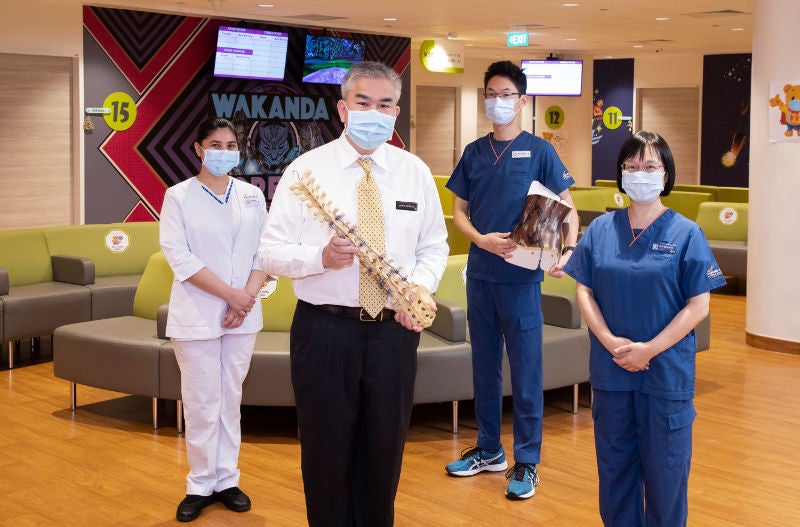
The Musculoskeletal Centre at KKH brings together various specialists to provide care for children with orthopaedic and spine conditions, some members include (from left to right) Ms Siti Hauzah Binte Abdul Rahaman, Assistant Nurse Clinician, Musculoskeletal Centre, KKH; Assoc Prof Kevin Lim, Chairman, Division of Surgery, KKH; Mr Nigel Wong, Prosthetist & Orthotist, Orthotics & Podiatry Service, KKH; Ms Tang Kiew Hoon, Principal Radiographer, DDII, KKH.
KK Women’s and Children’s Hospital (KKH) sees about 34,000 visits each year from children and adolescents with orthopaedic and spine conditions such as scoliosis, cerebral palsy and limb deformities.
Taking a unique approach amongst the region, KKH has created a seamless continuum of care for patients by establishing a complementary suite of services and facilities sited on one campus:
- A dedicated Musculoskeletal Centre housing clinics and facilities for sports and exercise medicine specialists, diagnostic and interventional imaging specialists, orthopaedic specialists and prosthetists and orthotists.
- Singapore's only one-stop paediatric orthotic centre providing a full range of orthotic services for children with lower limb and spine conditions requiring assistive devices.
- EOS Connect Imaging System for child-friendly and high-quality interventional and diagnostic imaging.
- 7D Machine-vision Image Guided Surgery (MvIGS) system for radiation-free, image-guided spine surgery.
“By redesigning the way patients experience integrated care, we are better able to provide the end-to-end support that each child needs to lead an active and fulfilling life and improve their quality of life in the long term,” says Associate Professor Kevin Lim, Chairman, Division of Surgery, KKH.

Assoc Prof Arjandas S/O Mahadev conducts a review for a patient with a lower limb condition.
Dedicated centre for children with musculoskeletal conditions
To provide a one-stop care experience for children with orthopaedic and spine conditions, the dedicated Musculoskeletal Centre houses clinics and facilities for specialists in diagnostic and interventional imaging, paediatric sports and exercise medicine, orthopaedics, and prosthetics and orthotics.
“The key healthcare disciplines our patients need are in one location for their convenience, and their care providers can collaborate with greater expediency afforded by proximity,” shares Ms Cha Mui Noi, Nurse Manager, Musculoskeletal Centre, KKH.
Building on feedback by patients and their families, the centre features wide, wheelchair-friendly sliding doors. Furniture and hardware are wall-mounted where possible, minimising physical barriers between the healthcare provider, patient and their family, and facilitating greater ease of examination and consultation.
“Establishing the Musculoskeletal Centre has not only formed new dimensions of collaboration among the hospital teams, but also further removed physical and mental barriers between the hospital as the healthcare provider, and the patient,” adds Associate Professor Arjandas S/O Mahadev, Head and Senior Consultant, Department of Orthopaedic Surgery, KKH.
Designing a child-friendly imaging experience
A key facility housed in the Musculoskeletal Centre is the EOS Connect Imaging System, which enables safe and high-quality interventional and diagnostic imaging for children with musculoskeletal conditions. Approximately 2,000 paediatric examinations are conducted each year using the EOS system.
“The EOS imaging system affords a child-friendly experience as it allows the child to stand, unrestrained, while being imaged. The images reflect the most realistic depiction of their natural posture, and the child does not have to switch position, as frontal and lateral full-body images are acquired simultaneously,” explains shares Dr Teo Sze Yiun, Head and Senior Consultant, Department of Diagnostic and Interventional Imaging (DDII), KKH.
The technology used produces a high-quality image with 50 per cent less radiation dosage, compared to digital radiography using a conventional X-ray system.
“Happiest of all for the child, their examination time is reduced, as the duration of time for the imaging of an entire spine is reduced by half, compared to conventional imaging systems,” adds Ms Tang Kiew Hoon, Principal Radiographer, DDII, KKH.
Radiographer Ms Tang Kiew Hoon demonstrates imaging with the EOS Connect system, for a patient requiring assistive devices.
Radiation-free machine-vision navigation for safer surgeries
To optimise surgical intervention for children with scoliosis requiring surgery, in July 2020, KKH introduced in Singapore, the 7D Machine-vision Image Guided Surgery (MvIGS) system for radiation-free, image-guided spine surgery.
“Technology augments our capacity to navigate more perceptively during surgery, particularly in unique cases of spine deformities or missing anatomy. Guided by real-time positioning software, the team can perform intricate procedures with greater efficiency and accuracy,” explains Assoc Prof Lim, who is also Senior Consultant, Department of Orthopaedic Surgery, KKH.

Assoc Prof Kevin Lim (centre) and team operate on a patient with scoliosis, using the 7DMvIGS system.
“Further on the patient safety front, we no longer require the use of intra-operative X-ray, rendering the surgery radiation-free. Blood loss and operative surgery time is also minimised for patients. This translates to reduced surgical risks such as lower complication rates and faster post-surgery recovery,” Assoc Prof Lim adds.
“We continue to push the possibilities of care to better meet the individual needs of children with scoliosis and other musculoskeletal conditions, and support their years of developmental growth ahead.”














 Get it on Google Play
Get it on Google Play